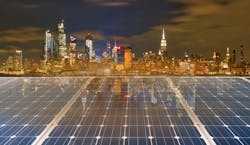Governor Kathy Hochul Announces 6.4 GW of Renewable Energy Investments in New York
New York Governor Kathy Hochul has announced an investment in renewable energy with conditional awards to three offshore wind and 22 land-based renewable energy projects totaling 6.4 GW of clean energy. This will be enough to power 2.6 million New York homes and deliver approximately 12% of the city’s electricity requirements once completed.
Combined with two marquee offshore wind blade and nacelle manufacturing facilities, the portfolio is expected to create approximately 8,300 family-sustaining jobs and spur $20 billion in economic development investments statewide. It will also include developer-committed investments to support disadvantaged communities.
The decision will support New York's target of having 70% of the state's electricity come from renewable sources by 2030 and having 9 GW of offshore wind by 2035 to achieve a zero-emission grid as required by the Climate Leadership and Community Protection Act.
With the announcement, New York will have enough operating, contracted, and under-development renewable energy projects to supply 79% of the state’s 2030 electricity needs with renewable energy.
“An investment of this magnitude is about more than just fighting climate change – we’re creating good-paying union jobs, improving the reliability of our electric grid, and generating significant benefits in disadvantaged communities,” said Governor Hochul. “Today, we are taking action to keep New York’s climate goals within reach, demonstrating to the nation how to recalibrate in the wake of global economic challenges while driving us toward a greener and more prosperous future for generations to come.”
The awarded projects will produce approximately 19 million MWh of new renewable energy per year, enough to:
- Power more than 2.6 million New York homes.
- Reduce greenhouse gas emissions by 9.4 million metric tons annually, equivalent to removing more than 2 million cars from the roads.
- Provide public health benefits resulting from reduced exposure to harmful pollutants.
- Deliver benefits to disadvantaged communities in line with the Climate Act goals, with over $3.5 billion in commitments to disadvantaged communities made by developers once operational.
To begin commercial operations in 2030, the three offshore wind projects totaling 4,032 MW of clean energy selected by NYSERDA are expected to displace over 7 million metric tons of CO2 annually, equivalent to removing 1.6 million cars from the road each year.
Additionally, the awarded projects will bring more than $15 billion in anticipated in-state spending and create more than 4,200 family-sustaining jobs across Long Island, New York City, and the Capital Region over the 25-year lifespan of the projects.
The projects will add benefits to New York’s economy, workforce, and environment, including:
- More than $85 million to support wildlife and fisheries research, mitigation, and enhancement.
- About $300 million in commitments to Minority and Women-Owned Business Enterprises (MWBEs) and Service-Disabled Veteran Owned Businesses (SDVOBs).
- Over $100 million to train New York’s workforce to build and service offshore wind projects.
The projects use a mixture of flexible and innovative transmission designs, including a reduced footprint in transmitting energy from offshore wind projects to New York City through HVDC and adaptable offshore electrical substations.
The average bill impact for customers will be approximately 2.73%, or about $2.93 per month, over the life of the projects, while the average all-in development cost of the offshore wind projects is $96.72 per MWh over the life of the contracts.
NYSERDA is also awarding $300 million to develop two supply chain facilities, including nacelle manufacturing and assembly by GE Vernova as well as blade manufacturing by LM Wind Power Blades USA, both planned for New York’s Capital Region.
While the investment will supply almost one-third of the total regional demand for offshore wind by 2035, it will also unlock $968 million in public and private funding, create 1,700 direct and indirect jobs supported by prevailing wage and project labor agreements, and result in over $3 billion in direct spending in the state.
The projects also align with available federal tax credits, enabling future savings for New York’s ratepayers.
The conditional land-based large-scale renewable awards include 14 new solar projects, six wind repowering projects, one new wind project, and one return-to-service hydroelectric project, totaling a combined 2,410 MW, enough new renewable generation to power over 560,000 New York homes annually for at least 20 years.
The projects are expected to spur over $4 billion in direct investments and create over 4,100 good-paying short- and long-term jobs across the state.
While the average bill impact for customers will be approximately 0.31%, or about $0.32 per month, over the life of the projects, the average all-in development cost of the awarded Tier 1 projects is $60.93 per MWh over the life of the contracts.
The projects feature over $108 million in commitments to disadvantaged communities made by developers as part of their proposals to NYSERDA and are also expected to result in over $38 million in commitments in spending to MWBEs and SDVOBs.
About the Author
EnergyTech Staff
Rod Walton is head of content for EnergyTech.com. He has spent 17 years covering the energy industry as a newspaper and trade journalist.
Walton formerly was energy writer and business editor at the Tulsa World. Later, he spent six years covering the electricity power sector for Pennwell and Clarion Events. He joined Endeavor and EnergyTech in November 2021.
He can be reached at [email protected].
EnergyTech is focused on the mission critical and large-scale energy users and their sustainability and resiliency goals. These include the commercial and industrial sectors, as well as the military, universities, data centers and microgrids.
Many large-scale energy users such as Fortune 500 companies, and mission-critical users such as military bases, universities, healthcare facilities, public safety and data centers, shifting their energy priorities to reach net-zero carbon goals within the coming decades. These include plans for renewable energy power purchase agreements, but also on-site resiliency projects such as microgrids, combined heat and power, rooftop solar, energy storage, digitalization and building efficiency upgrades.
